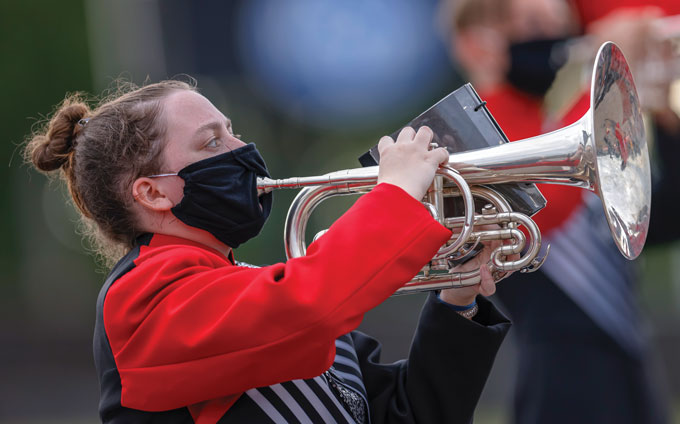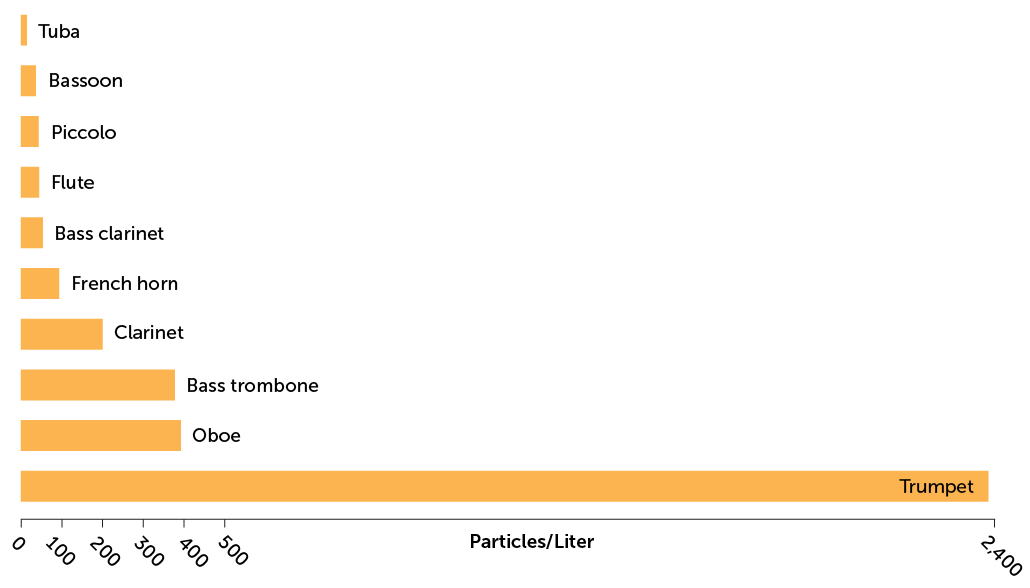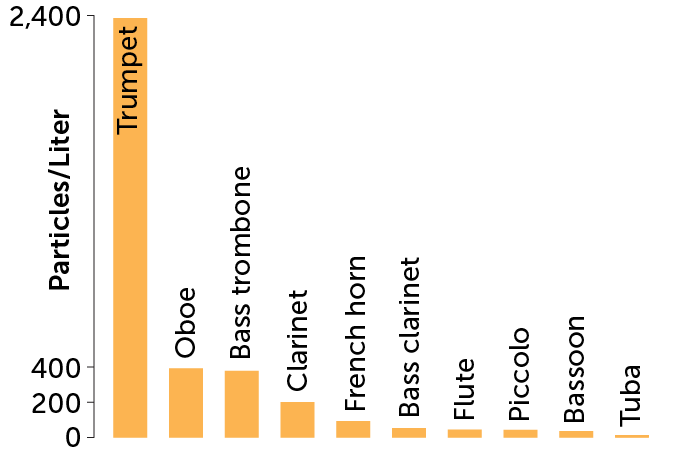What science tells us about reducing coronavirus spread from wind instruments
Performers and researchers collaborate to learn the risks and how to lower them

Members of the Rude Mechanical Orchestra, based in Brooklyn, N.Y., played at the St. Pat’s for All parade in March 2020. It was their last performance before COVID-19 shutdowns.
Erik McGregor/LightRocket via Getty Images
The last time I played clarinet with my band was on March 10, 2020. It was a typical Tuesday evening rehearsal: About 10 musicians crowded into a small basement room, sipping beers and chatting between tunes. Brass instruments, woodwinds and drums blared, with bass lines audible from the stairwell.
Since 2004, the Rude Mechanical Orchestra has practiced in the same space, a couple of blocks from the East River in Brooklyn, N.Y. The room is cramped — chairs and music stands crowd every corner, shelves are crammed with instruments and sheet music. With no windows or AC units, air circulation is minimal.
When I walked up the stairs after practice, I had no idea that the space we’d filled with boisterous pop covers and protest tunes would sit quiet for more than a year. The COVID-19 pandemic shut down the world in March 2020, isolating musicians like me from the art we love. Millions of high school and college musicians were barred from their band rooms, children’s lessons were canceled and professionals lost performance opportunities and income streams.
Though restrictions are now easing, we still face questions about how our instruments play into infection risk. Wind instruments — brasses as well as woodwinds like my clarinet — produce sound through human breath. And human breath spreads COVID-19. So how can we perform while keeping ourselves and our audiences safe, during the pandemic and beyond? To find answers, wind musicians, including myself, turned to science.
An ill wind
The hazards of live music hit home when news broke of a superspreader event among members of the Skagit Valley Chorale in Washington state. On March 10 — the same day as my band’s final rehearsal — 61 members had gathered to sing. By the time Gov. Jay Inslee instituted a stay-at-home order two weeks later, 52 members of the choir had either tested positive for the new coronavirus or were assumed to have it. Three singers were hospitalized, and two died.
The group had been careful, avoiding physical contact such as handshakes and hugs, putting plenty of space between their chairs and using hand sanitizer. At that time, the U.S. Centers for Disease Control and Prevention and other public health agencies were primarily telling people to avoid close contact and contaminated surfaces to reduce transmission risks. But many musicians quickly realized that something else was going on.
“When we saw the Skagit Valley choir spread, we knew right away that [the coronavirus] was spreading via aerosol,” says Mark Spede, director of bands at Clemson University in South Carolina. He is one of the lead researchers on a coalition that developed COVID-19 protocols for performing arts students. It was “pretty clear,” he says, that the virus was spreading through the air. On May 15, 2020, Skagit County health department staff reported in Morbidity and Mortality Weekly Report that the “act of singing, itself, might have contributed to transmission through emission of aerosols.”
I quickly realized that wind instruments like mine had to pose a similar danger. To play it safe, most wind musicians stopped playing together. My band briefly entertained the idea of practicing outside, but as New York City shut down, we switched to virtual rehearsals. These meetings were a poor substitute for in-person sessions. As anyone who’s tried to sing “Happy Birthday” over Zoom can tell you, videocalling platforms just don’t cut it for music practice. These platforms are built to highlight one speaker at a time, creating a painful lag in sound when people try to sing or play simultaneously (SN: 4/24/21, p. 22).
“School band shut down,” recalls 16-year-old Hannah Scheuer, a bandmate of mine and a student in the New York City public school system. Unable to enter the school building for months, classmates who rented instruments from the school couldn’t bring them home to practice. A survey conducted in late April by Spede and colleagues revealed that out of 30,000 U.S. high school and college music programs, about one-third had no in-person rehearsals through the end of the 2020–2021 school year.

Musicians in studies
Facing a lockdown without the camaraderie of rehearsals, musicians wanted answers about the risks their instruments might pose in spreading COVID-19. Some went as far as becoming study subjects to find out.
The Minneapolis-based Minnesota Orchestra, for instance, reached out to Jiarong Hong, a mechanical engineer at the nearby University of Minnesota. A July 2020 release of his study on indoor transmission of the coronavirus had drawn media attention; the study was later published in the January 2021 Journal of Aerosol Science. Catching wind of this work, the orchestra asked Hong and colleagues to “provide scientifically driven guidelines to help them get back to their work safely,” Hong says. His lab set up experiments with the musicians, which led to one of the first studies on the subject.
Engineer Lia Becher at the Bauhaus-Universität Weimar in Germany had an experience similar to Hong’s. When a colleague’s video demonstrating how air spreads after a cough went viral, musicians asked Becher and her lab group how air would spread out of their instruments. So she worked with local musicians to meticulously track the dispersion of air from instruments with mouthpieces.
Meanwhile, Spede and James Weaver, director of performing arts and sports for the National Federation of State High School Associations in Indianapolis, convened a group of concerned music teachers and arts organizations. They worked with mechanical engineers at the University of Colorado Boulder and the University of Maryland in College Park to study the risks posed by different performance activities, in the hopes of bringing students back to classrooms for fall 2020.
These studies and others like them fall into two categories, notes Juliette O’Keeffe, an environmental health scientist at the National Collaborating Centre for Environmental Health in Vancouver. Some, she explains, visualize the air coming out of an instrument (a qualitative method), while others measure properties of the air particles that emerge, such as size, concentration and distance traveled (a quantitative method). O’Keeffe conducted a review of studies that examined aerosols emitted from instruments and she posted her findings on her institution’s website on September 23, 2020.
Becher and colleagues employed qualitative methods, visualizing the air with a special mirror called a schlieren mirror. Using the temperature and pressure differences between static air and exhaled air, the mirror turns air patterns into visual light patterns. Videos produced by Becher’s team show exactly how air comes out of different instruments, in what looks like roiling puffs of smoke.
When a musician blows into their instrument, air particles escape through the instrument and the musician’s mouth. In these three clips, a schlieren mirror visualizes, via temperature and pressure change, how particles escape a flute, a trumpet, and a bass clarinet.
Hong’s lab followed quantitative methods, using an aerodynamic particle sizer — a special spectrometer that measures the diameters of tiny particles. These instruments can determine the sizes of aerosols that may spread the coronavirus (SN Online: 5/18/21).
Spede and Weaver’s collaborators used both quantitative and qualitative methods. This included the schlieren mirror and measurements taken in a dedicated aerosol testing room with a ventilation system that allows engineers to isolate the aerosols that emerged from the various instruments.
Which winds pose the highest risks?
For singers, all air comes directly out of the windpipe. But for wind musicians, once the air leaves the windpipe, its travel pattern depends on the instrument.
Hong’s team measured these patterns with musicians from the Minnesota Orchestra. The study’s findings, which he also published in the January 2021 Journal of Aerosol Science, measured risk by comparing the size and concentration of air particles dispersed by musicians with those emitted when a person speaks. Tubas were lowest risk, producing fewer particles than a person speaking. Flutes, French horns and larger woodwinds released similar levels of aerosols as a speaking person. Oboes, trombones and especially trumpets were all higher risk, spreading more aerosols than a person speaking.
Hong’s research provides specific aerosol sizes and concentration measurements for individual instruments. But this work, like other studies in this field, used very small sample sizes of one or two musicians to characterize an instrument’s air dispersion.
Such a small sample size can be particularly challenging when investigating woodwinds. While brass instruments are easy to evaluate, because all air goes straight from the mouthpiece to the bell, woodwinds get complicated. When I play my clarinet, aerosols have several escape routes: the flared opening at the instrument’s end, the keyholes and the space where my lips meet the reed — the thin piece of wood that vibrates against the clarinet’s mouthpiece to create sound. What’s more, small differences between clarinet players’ techniques can have a big impact on the speeds and concentrations of aerosols that players release.
In one trial by Hong’s team, one clarinet player produced five times as many aerosols as a second clarinet player. Hong hypothesizes that this difference is because one player used a “harder” clarinet reed, typically used by more experienced musicians. This reed is stiffer and requires more air to produce a sound. The way a clarinet player positions her mouth around her instrument may also affect aerosol generation, Hong explains.
Like Hong’s research, Becher’s work and preliminary findings from Spede and Weaver’s studies suggest that trumpets, trombones, clarinets and oboes spread more aerosols farther out into performance spaces, while larger instruments, particularly tubas, pose lower risks. The long, circuitous tubes in larger instruments trap breath-propelled particles and reduce the speed of those that do escape — in other words, you’re less likely to catch COVID-19 if you stand in front of a tuba player than if you stick your head into a tuba’s bell.
Although more research is needed, current studies nonetheless suggest that in most cases playing a wind instrument is about as likely (or even less likely) to transmit the coronavirus as loud talking or singing. The air is just traveling through your instrument’s tubing, rather than going straight out of your mouth. And there are ways to reduce risk.
We summarize the week's scientific breakthroughs every Thursday.
Safety tips
While Hong, Becher and other scientists researched particle dispersion from wind instruments, music nonetheless returned to the streets of New York in summer 2020, with many musicians inspired to support Black Lives Matter protests across the city. Eager to join the movement, the Rude Mechanical Orchestra began looking at studies, deliberating how to be safe. I and three other science-minded performers formed a COVID-19 committee.
Evaluating the literature was tricky. In an August 2020 e-mail exchange, committee member Phil Andrews sent the band a preprint from medRxiv.org, which suggested that fabric covers be stretched over brass instruments’ bells — the flared openings through which sound emerges. I wrote back with caution, noting that the study included only eight participants. Everything seemed preliminary, and because many of our bandmates have health conditions or families to look after, we opted for more caution. Until we knew more, we’d play only percussion instruments — outside.
Other musicians I spoke with remembered scouring the CDC’s website for any mention of wind instruments and carefully reading preprints in subjects that they had never studied. Benjamin Yates, a trombone instructor at the University of Louisiana in Lafayette, recalls an instance of intense research over the summer: “I was sitting at my computer and I had all these tabs open, and I’m looking up really basic terms, like ventilation — what does ventilation actually mean, scientifically?”
Yates’ and my efforts to align group practices with scientific recommendations reflected a broader trend across the nation to find safe ways to play music. While some musicians opted to stay in lockdown, others moved rehearsals and performances outside, often using makeshift bell covers or musician masks with space for a mouthpiece. A mask with a hole in it might seem odd, but research led by Spede and Weaver shows that these masks reduce aerosol spread from the sides of musicians’ mouths as they blow into their instruments. This is especially key for younger musicians who have less control over their mouth positioning.
Formulating safe strategies for musicians became especially important as U.S. school programs prepared for the 2020 fall semester. For Spede and Weaver, time was ticking on their project to build guidelines for student musicians. Preliminary investigations by engineers at the Universities of Colorado and Maryland provided the information they needed. This study, which included 12 performers playing nine different instruments, was published as a preprint on the University of Colorado’s website in April 2021. Before publication, however, Spede and Weaver’s team used the findings to devise detailed risk mitigation guidelines.
At the end of the 2020–2021 school year, Spede and Weaver surveyed U.S. high school and college music programs. Of 3,000 programs that responded, about 2,800 reported using some or all of the guidelines for bands, choirs or orchestras. Among those schools that responded, coronavirus spread was almost nonexistent. Eight programs each reported a case of coronavirus spread between musicians: five in choirs, two in bands and one in an orchestra. Seven of the eight cases involved one person infecting a single other person; two of the cases occurred at schools that did not use any of the recommended safety guidelines.
“With hundreds or thousands of hours of rehearsal and millions of people participating,” Weaver says, “the fact that we’ve had [so few] cases of spread, we’re pretty confident in the mitigations.” Spede and Weaver believe these protocols could be useful beyond the pandemic, for instance, during cold and flu seasons and other infectious disease outbreaks.
In addition to Spede and Weaver’s guidelines, musicians may consider reorganizing where they sit onstage. A modeling study by researchers at the University of Utah in Salt Lake City, based on Hong’s measurements, suggests that moving percussion instruments toward the center of the stage and putting the highest-risk winds near vents that pull air from the room can cut aerosol accumulation. The Utah Symphony, which collaborated with the University of Utah researchers on this study, adopted this recommendation for its spring 2021 concert season (SN Online: 6/23/21).
O’Keeffe also suggests that musicians monitor COVID-19 transmission rates in their communities, so they know the likelihood that a person with COVID-19 is present. Disease-tracking metrics used by the Brown University School of Public Health in Providence, R.I., indicate that more than 10 new cases a day for every 100,000 people in a region constitutes higher risk. Musicians may feel safer, too, when more than 70 percent of their community is fully vaccinated, adopting the vaccination goal from the White House COVID-19 task force.
An industry transformed
When I asked musicians how COVID-19 changed their musical activity, their answers reflected both the economic and emotional fallout of last spring’s lockdowns.
“Before COVID, I was working at my [former] high school as a school aide while giving lessons there as well,” says Elijah Herring, a saxophone student who graduated from New York’s Brooklyn College this spring. “Because the school system closed down, I lost my job. I wasn’t able to get unemployment benefits until June or July.… I had to street perform to make ends meet, to pay bills, to take care of my mom.”
In the short term, COVID-19 was a blow to the music world. Musicians lost income as well as motivation to practice or compose; some left the industry altogether. But in the long term, the pandemic has transformed how many musicians think about their profession.
“Music is a privilege,” says Orion White, a saxophone student at the University of Idaho in Moscow. “It’s something that really sticks with you; it changes you. It can be almost religious if you let it be, and I took that for granted. Not anymore.”
This sentiment is heightened by the layers of added challenge needed to play — any performance, group practice or even informal jam session now requires intensive safety and trust. Before they can start playing, musicians must trust each other with their vaccination status and other health information. I’ve led discussions in my own band, developing practice guidelines that incorporate health needs and risk comfort levels.
Audiences seem to acknowledge the effort that goes into performing. Andrews and Herring both say that they’re getting more money from busking now than they did before the pandemic.
The Rude Mechanical Orchestra had our first pandemic practice that included wind instruments on May 18 this year. We gathered outside, by the river, a few blocks away from our old basement practice space.
We had agreed to strict guidelines — all wind players had to be fully vaccinated, with masks and bell covers on. So only four people opted to play a wind instrument. Still, a tuba, two trombones, a clarinet and a lot of percussion was enough to bring melodies to life. We played through some of our classic tunes, pausing to talk through song structure and enjoy the breeze.
At one point, a small girl with a loose ponytail approached us and began dancing to the music. She didn’t know that we were out of practice or that half of the drummers were trained in other instruments. But her dance echoed our joy in being back together.









